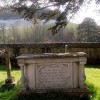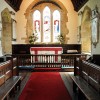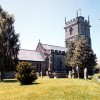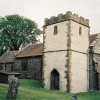The parish of West Stafford lies to the east of Dorchester and south of the River Frome its 1,000 acres dissected by the Winterborne, which flows north east across the parish. Within the parish boundaries there are several important houses including Stafford House parts of which are dated from 1633, with a more recent west front designed by the eminent Victorian architect Benjamin Ferry.
The present church survives from the 17th century but there are many indications of an earlier building. The west end of the south wall of a 15th century nave and the west tower built in the 16th century remain.
There is no structural division between the nave and chancel, rebuilt to a simple rectangular plan in 1640; the south porch was added at the same time. Further structural alterations were made in 1898 when the present chancel was added; the chancel screen was moved eastward and the 17th century chancel became a part of the nave. In the east wall of the chancel is a re-used 15th century window.
One of the two buttresses on the north wall of the nave is inscribed ‘John Dashwood 1640.’ The north doorway is blocked off and the easternmost window of the nave is of 1640 and the second window is of 16th century while the third window, which has a moulded oak lintel, also dates from 1640.
The south wall of the nave is dated 1640 but the western end is 15th century and the 16th century south doorway has stones numbered for rebuilding. The easternmost window and the third window in the south wall are 15th century but the second window is 16th century and similar to the second window in the north wall.
The roof of the nave (1640) is divided into panels by moulded ribs with turned pendants at the intersections. The elaborate panelling in the two easternmost bays shows the extent of the original chancel. At the back of the nave to the left of the door is a medieval baptismal font an octagonal straight sided bowl and notched square stem. The pews in the nave have been restored but date from 1640.
The three storeys of the 16th century west tower are divided externally by a moulded string course and have a moulded plinth, parapet string and embattled parapet and diagonal buttresses on the west end. A stair turret projects on the north side and rises higher than the main tower. There is a west doorway to the tower above which is a window: the second storey window in the east wall is 15th century. There is a window in each wall of the bell chamber, which houses three bells all by John Wallis, two are dated 1620 and one 1595.
The nave gives the impression of being smaller than its 45ft x 20ft dimensions; the panelled ceiling and the number of large wall and floor slab monuments is perhaps responsible. On the north wall a monument to William England, Archdeacon of Dorset 1835 and to Margaret his widow 1837; John Gould of Milbourne St. Andrew, erected by his executors in 1727. Hanging in the chancel is a brass candelabrum inscribed ‘The Gift of John Gould Esqr. Anno Domi 1713.’ The Royal Arms of King James I painted on wood panel with a painted frame. On the south is a wall monument to Richard Russell 1638, Richard Russell 1660, Richard Russell 1667, Rectors and patrons, erected by Elizabeth Russell in 1674. On the north and south walls of the nave the remains of theDecalogue and Creed in black lettering 1640.
There are several brasses on the nave walls including on the north wall, to Giles Long, patron of the living, 1592; and on the south wall to Robert White 1680; to Robert White, grandson of Richard Russell, Rector and patron. In the chancel there are four 18th and 19th century paintings, copies of old masters.
Literary scholars will tell you of West Stafford’s associations with Thomas Hardy. St. Andrew’s is the setting for the marriage of Angel Clare to Tess and a little to the east of the village on Talbot’s Mead is Talbothay’s Lodge, which Hardy designed for his brother. Travel a little farther east and you will come across Lower Lewell Farm, the place where Angel and Tess met, in Hardy’s novel it is called Talbothay’s Dairy.



